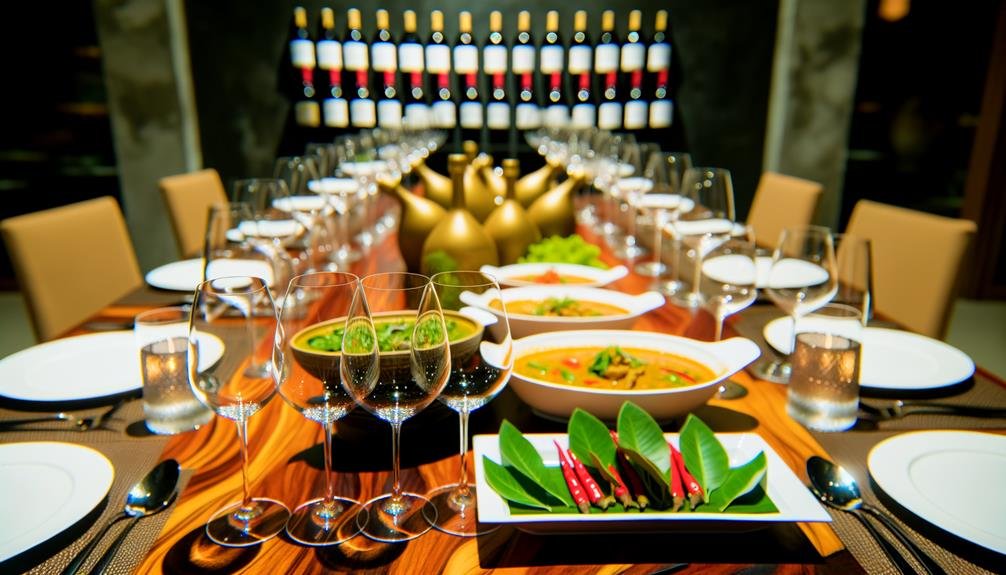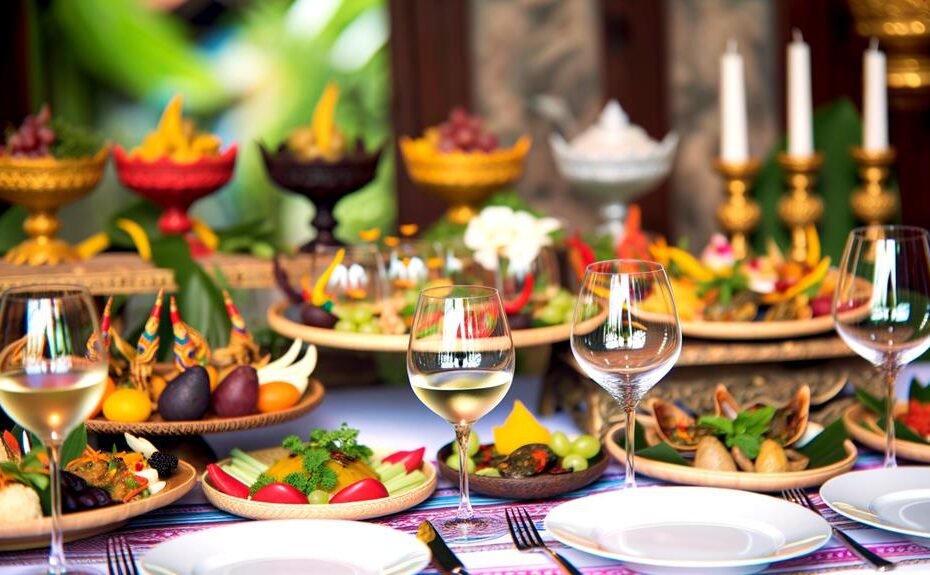Pairing wine with Thai cuisine is a delicate art, requiring a deep understanding of flavors and aromas. For example, Riesling and Pinot Gris can enhance the sweet and sour notes, while Pinot Noir can bring out herbal undertones.
The key is finding a balance between acidity, sweetness, and fruitiness to complement the spices and textures in the dishes. It's all about creating a harmonious experience on the palate, where each sip and bite enhance each other.
By exploring the nuances of each wine and dish pairing, one can truly appreciate the symphony of flavors that unfold.
Ideal White Wines

When pairing wine with Thai cuisine, Riesling is a top choice for white wine. Its blend of tropical fruit flavors, acidity, and sweetness creates a perfect match for the complex flavors of Thai dishes.
If you're looking for variety, consider other white wines like Pinot Gris, Chenin Blanc, Grenache Blanc, and Gruner Veltliner, which all complement the sweet, sour, salty, spicy, and bitter notes in Thai food.
For a refreshing twist, try Sparkling Rose with its bubbly effervescence and subtle fruitiness. These wine selections can enhance your Thai dining experience by creating a harmonious balance between the food and drink.
Red Wine Pairings
When it comes to pairing red wines with Thai cuisine, Pinot Noir and Zweigelt are top choices. Pinot Noir's light body and bright acidity complement the aromatic herbs and sweet-savory balance in Thai dishes like Pad See Ew. Its red fruit notes add a refreshing touch to the meal.
On the other hand, Zweigelt, an Austrian varietal, brings a spicier element with peppery undertones and vibrant berry flavors, making it a great match for heartier Thai curries. These wines bring a new dimension to traditional Thai flavors, enhancing the dining experience with their unique profiles.
Key Thai Ingredients
Thai cuisine's bold flavors stem from essential ingredients like palm sugar, tamarind, fish sauce, hot chilies, and aromatic herbs. These elements combine to create a harmonious balance of sweet, sour, salty, and spicy tastes that define the cuisine.
Palm sugar brings a deep sweetness, tamarind adds a tangy complexity, and fish sauce offers a savory depth that complements the heat of chilies. Aromatic herbs like lemongrass, kaffir lime leaves, and Thai basil contribute freshness and layers of flavor.
Understanding these key ingredients is crucial for creating wine pairings that elevate the dining experience, as they interact with wine's acidity, sweetness, and tannins to create delightful combinations.
Pairing Specific Dishes
Understanding key Thai ingredients can help enhance the flavors of Thai dishes when paired with the right wine. Pad Thai, known for its sweet-savory taste, pairs well with off-dry Riesling, balancing acidity and sweetness.
The rich flavors of soy and garlic in Pad See Ew are complemented by Pinot Noir, adding a subtle fruity touch.
Gewurztraminer's floral notes contrast beautifully with the aromatic Red and Green Curries.
Carignan's robust character is a great match for the warm spices and coconut milk in Massaman Curry.
Lastly, the crispness of Sparkling Rosé enhances the crunchiness of Thai Spring Rolls, creating a refreshing dining experience.
Exploring Flavor Balance

Pairing wine with Thai cuisine requires an understanding of the intricate flavor balance in each dish. Thai food blends sweet, sour, salty, spicy, and bitter flavors to create a complex taste experience.
To complement these diverse flavors, wines should either mirror or balance this complexity. For example, a Riesling's acidity and sweetness can harmonize with the spicy and sweet notes in Thai dishes, while a Pinot Noir's light tannins and fruity flavors can enhance the savory elements.
The key is to create a symbiotic relationship where neither the wine nor the dish overpowers the other. By appreciating the delicate balance within Thai cuisine, one can discover unique wine pairings that enhance the overall dining experience.
Conclusion
Understanding how specific wines can enhance the flavors of Thai cuisine can truly elevate a dining experience. Pairing wines like Riesling, Pinot Gris, or Pinot Noir with Thai dishes can create a delightful harmony of tastes.
By focusing on the balance of acidity, sweetness, and fruitiness, diners can unlock a symphony of flavors that complement each other perfectly. This marriage of flavors can take a meal from enjoyable to extraordinary, showcasing the beauty of pairing wine with the intricate flavors of Thai dishes.
